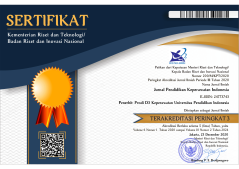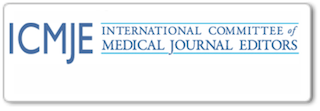The Relationship of Early Complementary Feeding (CF) with Nutritional Status to Children Aged 6-24 Months towards Family Farmers
Abstract
Complementary feeding (CF) practices have an essential role in determining the nutritional status of children. Children who are given early complementary feeding (ECF) are at risk of malnutrition. Besides, children with family farmers tend to have wasting or overweight because they cannot provide food in a variety, quantity, and quality according to the nutritional needs of their children. This study aimed to determine the relationship of ECF with nutritional status in children 6-24 months towards family farmers. This correlational study was conducted using a cross-sectional approach. Samples were 75 children aged 6-24 months selected using purposive sampling. This research was conducted at Geger Health Center Bangkalan Regency. Data collection was done by giving questionnaires to children parents. Children's weight-for-height z-score (WHZ) were calculated using WHO Anthro version application 3.2.2. The chi-square test analyzed the association between CF and nutritional status. The results of the study showed that the nutritional status of 75 children was normal (72%), overweight (25.3%), and wasted (2.7%). Most mothers have been given ECF since infants aged two months (29.3%) and 0 months (13%), which caused 36.4% of children to become overweight. Bivariate analysis showed a significant relationship between CF with nutritional status to children aged 6-24 months towards family farmers (p-value=0.033). ECF caused children aged 6-24 months to become overweight. Therefore, it is hoped that health workers will always give health education to increase mothers' knowledge about exclusive breastfeeding to support the nutritional status of children aged 6-24 months towards family farmers.
Keywords
References
Anggraeni, E. M., Herawati, D. M. D., Rusmil, V. K., & Hafsah, T. (2020). Perbedaan status gizi bayi usia 6-9 bulan yang diberi MPASI buatan pabrik dan rumah. Jurnal Gizi Klinik Indonesia, 16(3), 106-113.
Blaney S, Februhartanty J, S. S. (2015). Feeding Practices among Indonesian Children Above Six Months of Age: A Literature Review on Their Magnitude and Quality (part 1). Asia Pac J Clin Nutr, 24(1), 16-27.
Dev, M.,Shaikh, S., Rehana, S., Shabdum, I., Adil, I, M. 2013. Knowledge of Complementary Feeding of Mothers having Infants Younger than 2 Years of Aged- A community-Based Study. Pediatr J. 37 (3): 149-155.
Doutel, E. J., Picauly, I., & Salmun, J. A. R. (2019). Determinants of Toddler Nutritional Status in Farmers' Families in the Work Area of the Halilulik Health Center in Belu Regency in 2019. Journal of Community Health, 1 (3), 103–110.
Haszard JJ, Russell CG, Byrne RA, Taylor RW, C. K. (2019). Early maternal Feeding Practices: Associations with overweight Later in Childhood. Appetite, 132, 91-6.
Hermiyanty, Wandira Ayu Bertin, D. S. (2017). 済無No Title No Title. Journal of Chemical Information and Modeling, 8(9), 1–58.
Illahi, R. K. & Muniroh, L. 2016. Description of Socio-Cultural of Madurese Ethnic to Nutrition and Stunting Incidence of Toddlers Ages 24-59 Months in Bangkalan Regency. Media Gizi Indonesia. 11, 135–143.
Kumala, H. R., & Purnomo, W. (2019). Relationship Between Exclusive Breastfeeding with Development of Toddlers Who Have Low Birth Weight History, 8(2), 33–39.
Laving, A. R., Hussain, S. R. A., & Atieno, D. O. (2018). Overnutrition: Does complementary feeding Play a Role? Annals of Nutrition and Metabolism, 73(suppl 1), 15–18.
Maciel, B. L. L., Moraes, M. L., Soares, A. M., Cruz, I. F. S., Andrade, M. I. R. De, Filho, J. Q., & Junior, F. S. (2018). Infant Feeding Practices and Determinant Variables for Early Complementary Feeding in The First 8 Months of Life : Results from the Brazilian MAL-ED cohort site, 21(13), 2462–2470.
Nordang, S., Shoo, T., Holmboe-Ottesen, G., Kinabo, J., & Wandel, M. (2015). Women’s Work in Farming, Child Feeding Practices and Nutritional Status among Under-Five Children in Rural Rukwa, Tanzania. British Journal of Nutrition, 114(10), 1594–1603.
Nzefa, L., Monebenimp, F., & Äng, C. (2018). Undernutrition among children under five in the Bandja village of Cameroon, Africa. South African Journal of Clinical Nutrition, 32(2), 46-50.
Pandey, V. L., Mahendra Dev, S., & Jayachandran, U. (2016). Impact of agricultural interventions on the nutritional status in South Asia: A review. Food Policy, 62, 28–40.
Park, S.J., Lee, H. J. (2017). Exclusive Breastfeeding and Partial Breastfeeding Reduce the Risk of Overweight in Childhood : A Nationwide Longitudinal Study in Korea. Obesity Research and Clinical Practice, 12(2), 222-228.
Qanit, S., Bangsawan, C, C. 2020. Early Complementary Feeding Increases the Risk of Obesity in Children. Journal of Nursing Research prof. 2(1) 91-98.
Safitri, A. M., Pangestuti, D. R., & Aruben, R. (2017). The Relationship of Family Food Security and Consumption Patterns with the Nutritional Status of Toddler Farmers' Families. Kesehatan Masyarakat, 5(3), 120–128.
Sariy, R. B., Simanjuntak, B. Y., & Suryani, D. (2018). Pemberian MP-ASI dini dengan status gizi (PB/U) usia 4-7 bulan di Kecamatan Ratu Samban Kota Bengkulu. AcTion: Aceh Nutrition Journal, 3(2), 103.
Schneider, B. C., Gatica-Domínguez, G., Assuncąõ, M. C. F., Matijasevich, A., Barros, A. J. D., Santos, I. S., & Silveira, M. F. (2020). Introduction to Complementary Feeding in The First Year of Life and Risk of Overweight at 24 Months of Age: Changes From 2004 to 2015 Pelotas (Brazil) Birth Cohorts. British Journal of Nutrition, 124(6), 620–630.
Symon B, Crichton GE, Muhlhausler B. 2017. Does the Early Introduction of Solids Promote Obesity?. Singapore Med J. 8(11), 626-631.
Wang J, Wu Y, Xiong G, Chao T, Jin Q, Liu R. (2016). Introduction of Complementary Feeding Before 4 Months of Age Increases The Risk of Childhood Overweight or Obesity: A Meta-Analysis of Prospective Cohort Studies. Nutr Res, 36(8), 759-770.
Yan J, Liu L, Zhu Y, Huang G, Wang PP. 2014. The Association between Breastfeeding and Childhood Obesity: a Meta-Analysis. BMC Public Health. 14, 1-11.
DOI: https://doi.org/10.17509/jpki.v7i2.39084
Refbacks
Jurnal Pendidikan Keperawatan Indonesia(JPKI) published by Indonesia University of Education. JPKI is licensed under a Creative Commons Attribution-ShareAlike 4.0 International License.
Office :
Nursing Department. FPOK UPI.
229, Dr. Setiabudhi Street. Bandung 40154
West Java , Indonesia
E-mail : jpki@upi.edu

_.png)
_.png)
_.png)











